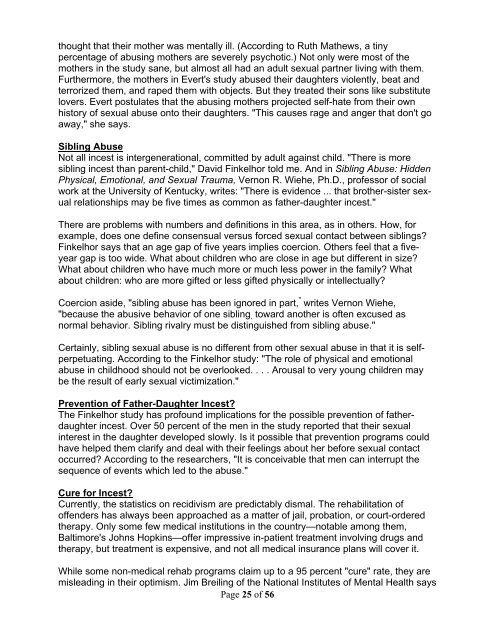Do you want to know what incest is? What it really is? No ...
Do you want to know what incest is? What it really is? No ...
Do you want to know what incest is? What it really is? No ...
Create successful ePaper yourself
Turn your PDF publications into a flip-book with our unique Google optimized e-Paper software.
thought that their mother was mentally ill. (According <strong>to</strong> Ruth Mathews, a tiny<br />
percentage of abusing mothers are severely psychotic.) <strong>No</strong>t only were most of the<br />
mothers in the study sane, but almost all had an adult sexual partner living w<strong>it</strong>h them.<br />
Furthermore, the mothers in Evert's study abused their daughters violently, beat and<br />
terrorized them, and raped them w<strong>it</strong>h objects. But they treated their sons like subst<strong>it</strong>ute<br />
lovers. Evert postulates that the abusing mothers projected self-hate from their own<br />
h<strong>is</strong><strong>to</strong>ry of sexual abuse on<strong>to</strong> their daughters. "Th<strong>is</strong> causes rage and anger that don't go<br />
away," she says.<br />
Sibling Abuse<br />
<strong>No</strong>t all <strong>incest</strong> <strong>is</strong> intergenerational, comm<strong>it</strong>ted by adult against child. "There <strong>is</strong> more<br />
sibling <strong>incest</strong> than parent-child," David Finkelhor <strong>to</strong>ld me. And in Sibling Abuse: Hidden<br />
Physical, Emotional, and Sexual Trauma, Vernon R. Wiehe, Ph.D., professor of social<br />
work at the Univers<strong>it</strong>y of Kentucky, wr<strong>it</strong>es: "There <strong>is</strong> evidence ... that brother-s<strong>is</strong>ter sexual<br />
relationships may be five times as common as father-daughter <strong>incest</strong>."<br />
There are problems w<strong>it</strong>h numbers and defin<strong>it</strong>ions in th<strong>is</strong> area, as in others. How, for<br />
example, does one define consensual versus forced sexual contact between siblings?<br />
Finkelhor says that an age gap of five years implies coercion. Others feel that a fiveyear<br />
gap <strong>is</strong> <strong>to</strong>o wide. <strong>What</strong> about children who are close in age but different in size?<br />
<strong>What</strong> about children who have much more or much less power in the family? <strong>What</strong><br />
about children: who are more gifted or less gifted physically or intellectually?<br />
Coercion aside, "sibling abuse has been ignored in part, " wr<strong>it</strong>es Vernon Wiehe,<br />
"because the abusive behavior of one sibling, <strong>to</strong>ward another <strong>is</strong> often excused as<br />
normal behavior. Sibling rivalry must be d<strong>is</strong>tingu<strong>is</strong>hed from sibling abuse."<br />
Certainly, sibling sexual abuse <strong>is</strong> no different from other sexual abuse in that <strong>it</strong> <strong>is</strong> selfperpetuating.<br />
According <strong>to</strong> the Finkelhor study: "The role of physical and emotional<br />
abuse in childhood should not be overlooked. . . . Arousal <strong>to</strong> very <strong>you</strong>ng children may<br />
be the result of early sexual victimization."<br />
Prevention of Father-Daughter Incest?<br />
The Finkelhor study has profound implications for the possible prevention of fatherdaughter<br />
<strong>incest</strong>. Over 50 percent of the men in the study reported that their sexual<br />
interest in the daughter developed slowly. Is <strong>it</strong> possible that prevention programs could<br />
have helped them clarify and deal w<strong>it</strong>h their feelings about her before sexual contact<br />
occurred? According <strong>to</strong> the researchers, "It <strong>is</strong> conceivable that men can interrupt the<br />
sequence of events which led <strong>to</strong> the abuse."<br />
Cure for Incest?<br />
Currently, the stat<strong>is</strong>tics on recidiv<strong>is</strong>m are predictably d<strong>is</strong>mal. The rehabil<strong>it</strong>ation of<br />
offenders has always been approached as a matter of jail, probation, or court-ordered<br />
therapy. Only some few medical inst<strong>it</strong>utions in the country—notable among them,<br />
Baltimore's Johns Hopkins—offer impressive in-patient treatment involving drugs and<br />
therapy, but treatment <strong>is</strong> expensive, and not all medical insurance plans will cover <strong>it</strong>.<br />
While some non-medical rehab programs claim up <strong>to</strong> a 95 percent "cure" rate, they are<br />
m<strong>is</strong>leading in their optim<strong>is</strong>m. Jim Breiling of the National Inst<strong>it</strong>utes of Mental Health says<br />
Page 25 of 56


